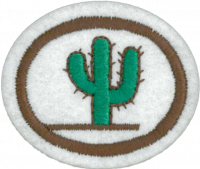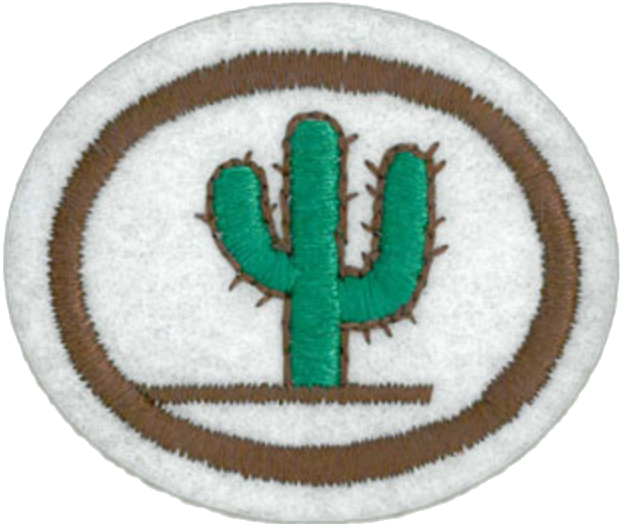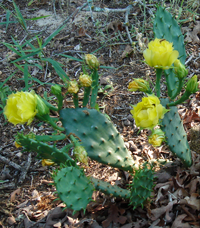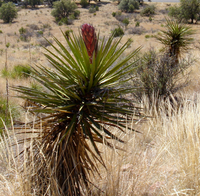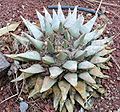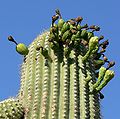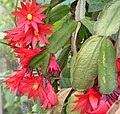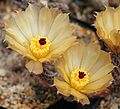Difference between revisions of "AY Honors/Cacti/Answer Key"
From Pathfinder Wiki
m (Reverted edits by Peoplerueme (Talk) to last revision by CommonsDelinker) |
m |
||
| (31 intermediate revisions by 8 users not shown) | |||
| Line 1: | Line 1: | ||
| − | {{ | + | {{HonorSubpage}} |
| − | + | <section begin="Body" /> | |
| − | + | {{ansreq|page={{#titleparts:{{PAGENAME}}|2|1}}|num=1}} | |
| + | <noinclude><translate><!--T:27--> | ||
| + | </noinclude> | ||
| + | <!-- 1. Name the chief characteristics of a cactus. --> | ||
:Areoles - Flowers, branches, spines sprout from these- no other plant has this feature. | :Areoles - Flowers, branches, spines sprout from these- no other plant has this feature. | ||
| − | :Spines - | + | <!--T:3--> |
| + | :Spines - Perhaps the most familiar feature of cacti, spines can vary greatly in appearance, shape, size, and color. Spines are not thorns. | ||
| − | :Flowers - Flowers are not unique to cacti, but cacti flowers are unique. Cacti flowers are typically quite spectacular and very complex. Unfortunately this field mark is only helpful | + | <!--T:4--> |
| + | :Flowers - Flowers are not unique to cacti, but cacti flowers are unique. Cacti flowers are typically quite spectacular and very complex. Unfortunately this field mark is only helpful if the plant happens to be blooming. | ||
| + | <!--T:5--> | ||
:Leaves - Most cacti do not have leaves, however, some do. Pay special attention to the presence or absence of leaves. | :Leaves - Most cacti do not have leaves, however, some do. Pay special attention to the presence or absence of leaves. | ||
| − | :Origin - | + | <!--T:6--> |
| + | :Origin - All cacti are native to the America's and surrounding islands. With one exception - Rhipsalis baccifera. Although, world wide cultivation has made this less helpful for identification. | ||
| − | ==2. Name three uses of cacti. | + | <!--T:28--> |
| + | <noinclude></translate></noinclude> | ||
| + | {{CloseReq}} <!-- 1 --> | ||
| + | {{ansreq|page={{#titleparts:{{PAGENAME}}|2|1}}|num=2}} | ||
| + | <noinclude><translate><!--T:29--> | ||
| + | </noinclude> | ||
| + | <!-- 2. Name three uses of cacti. --> | ||
:Cacti are used for: | :Cacti are used for: | ||
| − | :1. '''Decorating''' - as [[W:Houseplants|houseplants]], in [[W:Xeriscape|dry gardens]], or, even as a [[W:Cactus_fence|fence]]. | + | <!--T:8--> |
| + | :1. '''Decorating and Landscaping''' - as [[W:Houseplants|houseplants]], in [[W:Xeriscape|dry gardens]], or, even as a [[W:Cactus_fence|fence]]. | ||
| + | <!--T:9--> | ||
:2. '''Edible Fruit Producing''' - such as [[W:Opuntia|Prickly Pear]], [[W:Hylocereus|Hylocereus]], [[W:Dragon_fruit|Dragon fruit]]. | :2. '''Edible Fruit Producing''' - such as [[W:Opuntia|Prickly Pear]], [[W:Hylocereus|Hylocereus]], [[W:Dragon_fruit|Dragon fruit]]. | ||
| + | <!--T:10--> | ||
:3. '''Psychoactive uses''' - the [[W:Peyote|Peyote]], ''Lophophora williamsii'', is a well-known [[W:Psychoactive|psychoactive agent]] used by Native Americans in southwestern United States. | :3. '''Psychoactive uses''' - the [[W:Peyote|Peyote]], ''Lophophora williamsii'', is a well-known [[W:Psychoactive|psychoactive agent]] used by Native Americans in southwestern United States. | ||
| + | <!--T:11--> | ||
:4. '''Host for bugs''' - the [[W:Opuntia|Opuntia]] is also used as a host for cochineal bugs for the [[W:Cochineal|Cochineal]] dye industry. | :4. '''Host for bugs''' - the [[W:Opuntia|Opuntia]] is also used as a host for cochineal bugs for the [[W:Cochineal|Cochineal]] dye industry. | ||
| − | ==3. In what places are cacti the most plentiful? Why? | + | <!--T:12--> |
| + | :5. '''Food''' - Nopal cactus has been a staple food and base for beverages in Mexican culture for centuries. | ||
| + | |||
| + | <!--T:13--> | ||
| + | :6. '''Emergency water source''' - Some cactus can serve as an emergency water source, but be careful as you can get diarrhea causing further dehydration. | ||
| + | |||
| + | <!--T:30--> | ||
| + | <noinclude></translate></noinclude> | ||
| + | {{CloseReq}} <!-- 2 --> | ||
| + | {{ansreq|page={{#titleparts:{{PAGENAME}}|2|1}}|num=3}} | ||
| + | <noinclude><translate><!--T:31--> | ||
| + | </noinclude> | ||
| + | <!-- 3. In what places are cacti the most plentiful? Why? --> | ||
| + | <!--T:15--> | ||
:Cacti can adapt very well to dry climate or rocky terrain like deserts or mountains, but they can thrive in jungles. They prefer a hot, dry climate, not a humid, hot climate as popular myth suggests. The fact that they also thrive on sandy/rock soil is because the way water doesn’t pool near or on them and the nutrients the soil is rich with. | :Cacti can adapt very well to dry climate or rocky terrain like deserts or mountains, but they can thrive in jungles. They prefer a hot, dry climate, not a humid, hot climate as popular myth suggests. The fact that they also thrive on sandy/rock soil is because the way water doesn’t pool near or on them and the nutrients the soil is rich with. | ||
| − | ==4. Know and identify from life or pictures 15 species of cacti. | + | <!--T:32--> |
| + | <noinclude></translate></noinclude> | ||
| + | {{CloseReq}} <!-- 3 --> | ||
| + | {{ansreq|page={{#titleparts:{{PAGENAME}}|2|1}}|num=4}} | ||
| + | <noinclude><translate><!--T:33--> | ||
| + | </noinclude> | ||
| + | <!-- 4. Know and identify from life or pictures 15 species of cacti. --> | ||
| + | <!--T:17--> | ||
Hey! This is '''your''' part. Enjoy! | Hey! This is '''your''' part. Enjoy! | ||
| + | <!--T:18--> | ||
I took photos of these two. Can you identify them? | I took photos of these two. Can you identify them? | ||
| + | <!--T:19--> | ||
[[Image:Cacti70512c.png|thumb|right|200px|Cacti]] | [[Image:Cacti70512c.png|thumb|right|200px|Cacti]] | ||
[[Image:Cacti70315a-davismtns.png|thumb|left|200px|Davis Mountains]] | [[Image:Cacti70315a-davismtns.png|thumb|left|200px|Davis Mountains]] | ||
| + | <!--T:20--> | ||
<br style="clear:both"> | <br style="clear:both"> | ||
| + | <!--T:21--> | ||
Now go and identify more... | Now go and identify more... | ||
| + | <!--T:22--> | ||
<gallery> | <gallery> | ||
Image:cactaceae-compass_barrel.jpg | Image:cactaceae-compass_barrel.jpg | ||
| Line 58: | Line 100: | ||
<br style="clear:both"> | <br style="clear:both"> | ||
| − | ==5. Photograph, observe or sketch at least 10 species of cacti and classify them or grow at least 3 different species of cacti. | + | <!--T:34--> |
| + | <noinclude></translate></noinclude> | ||
| + | {{CloseReq}} <!-- 4 --> | ||
| + | {{ansreq|page={{#titleparts:{{PAGENAME}}|2|1}}|num=5}} | ||
| + | <noinclude><translate><!--T:35--> | ||
| + | </noinclude> | ||
| + | <!-- 5. Photograph, observe or sketch at least 10 species of cacti and classify them or grow at least 3 different species of cacti. --> | ||
| + | <!--T:24--> | ||
There are different [[W:Taxonomy_of_the_Cactaceae|tribes of cacti]]: | There are different [[W:Taxonomy_of_the_Cactaceae|tribes of cacti]]: | ||
<gallery> | <gallery> | ||
| Line 77: | Line 126: | ||
</gallery> | </gallery> | ||
| − | ==References== | + | <!--T:36--> |
| − | [[Category:Adventist Youth Honors Answer Book | + | <noinclude></translate></noinclude> |
| − | + | {{CloseReq}} <!-- 5 --> | |
| + | <noinclude><translate></noinclude> | ||
| + | ==References== <!--T:25--> | ||
| + | <noinclude></translate></noinclude> | ||
| + | |||
| + | [[Category:Adventist Youth Honors Answer Book/Do at home{{GetLangSuffix}}]] | ||
| + | {{CloseHonorPage}} | ||
Latest revision as of 17:05, 3 January 2023
1
Name the chief characteristics of a cactus.
- Areoles - Flowers, branches, spines sprout from these- no other plant has this feature.
- Spines - Perhaps the most familiar feature of cacti, spines can vary greatly in appearance, shape, size, and color. Spines are not thorns.
- Flowers - Flowers are not unique to cacti, but cacti flowers are unique. Cacti flowers are typically quite spectacular and very complex. Unfortunately this field mark is only helpful if the plant happens to be blooming.
- Leaves - Most cacti do not have leaves, however, some do. Pay special attention to the presence or absence of leaves.
- Origin - All cacti are native to the America's and surrounding islands. With one exception - Rhipsalis baccifera. Although, world wide cultivation has made this less helpful for identification.
2
Name three uses of cacti.
- Cacti are used for:
- 1. Decorating and Landscaping - as houseplants, in dry gardens, or, even as a fence.
- 2. Edible Fruit Producing - such as Prickly Pear, Hylocereus, Dragon fruit.
- 3. Psychoactive uses - the Peyote, Lophophora williamsii, is a well-known psychoactive agent used by Native Americans in southwestern United States.
- 4. Host for bugs - the Opuntia is also used as a host for cochineal bugs for the Cochineal dye industry.
- 5. Food - Nopal cactus has been a staple food and base for beverages in Mexican culture for centuries.
- 6. Emergency water source - Some cactus can serve as an emergency water source, but be careful as you can get diarrhea causing further dehydration.
3
In what places are cacti the most plentiful? Why?
- Cacti can adapt very well to dry climate or rocky terrain like deserts or mountains, but they can thrive in jungles. They prefer a hot, dry climate, not a humid, hot climate as popular myth suggests. The fact that they also thrive on sandy/rock soil is because the way water doesn’t pool near or on them and the nutrients the soil is rich with.
4
Know and identify from life or pictures 15 species of cacti.
Hey! This is your part. Enjoy!
I took photos of these two. Can you identify them?
Now go and identify more...
5
Photograph, observe or sketch at least 10 species of cacti and classify them or grow at least 3 different species of cacti.
There are different tribes of cacti:
B. hertlingiana (Tribe Browningia)
Ariocarpus retusus (Tribe Cacteae)
Calymmanthium (Tribe Calymmantheae)
Cereus peruvianus (Tribe Cereeae)
Hylocereus undatus (Tribe Hylocereeae)
Parodia magnifica (Tribe Notocacteae)
Golden cereus (Tribe Pachycereeae)
Schlumbergera gaertneri (Tribe Rhipsalideae)
D. rhodacantha (Tribe Trichocereeae)
A. subulata (Tribe Austrocylindropuntieae)
Cuija (Tribe Opuntieae)
Pterocactus tuberosus (Tribe Pterocacteae)
Maihueniopsis subterranea (Tribe Tephrocacteae)
